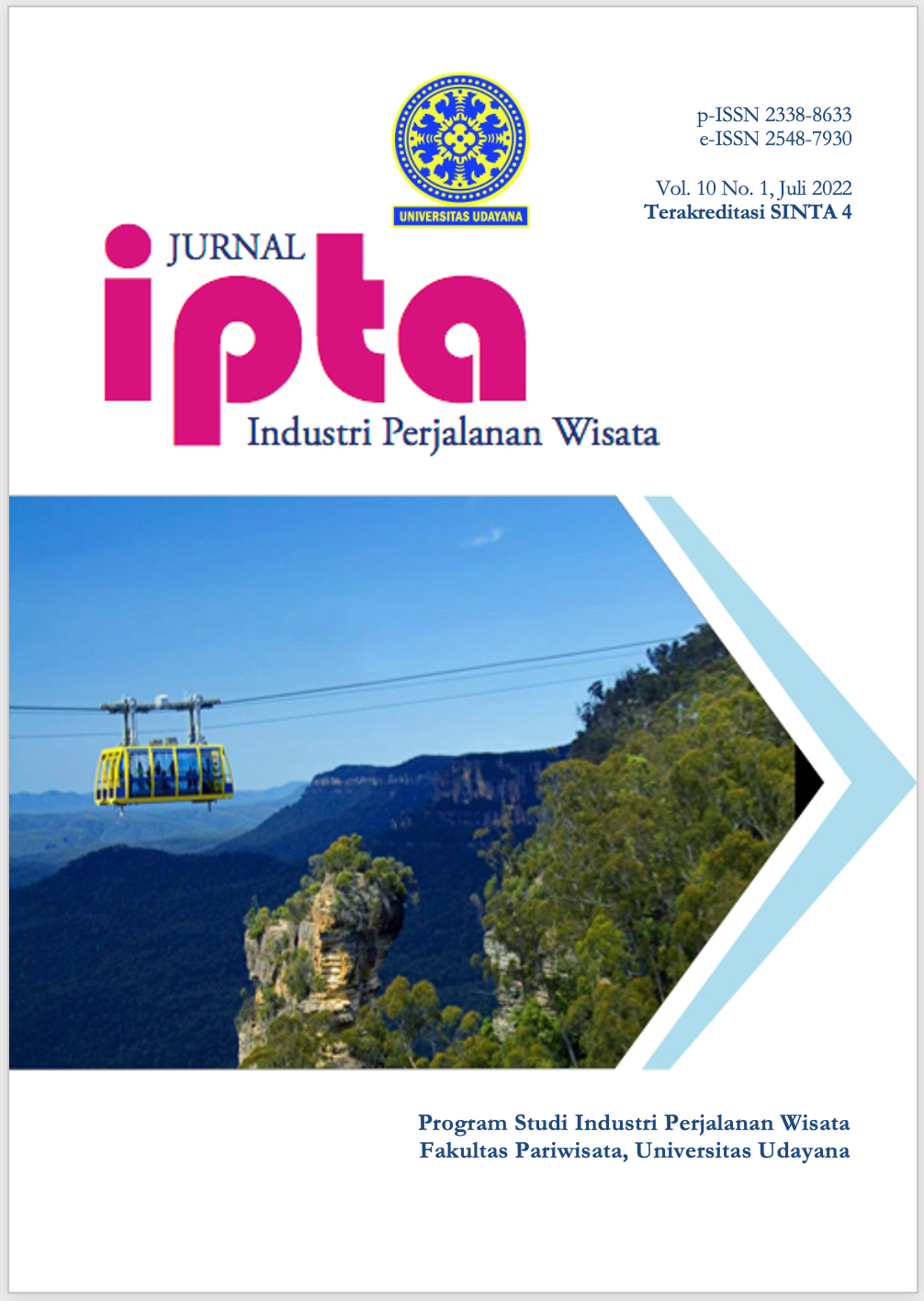PENERAPAN TECHNOLOGY ACCEPTANCE MODEL PADA RANCANGAN BUKU ELEKTRONIK PANDUAN PERJALANAN WISATA SEJARAH KOTA BANDUNG
Abstract
Historical tourism resources are one of the comparative and comparative advantages of Bandung city to other tourist destinations in Indonesia. The special characteristic of historical tourism is that the power of narratives poses a broader need for means of interpretation in the form of travel guides. Through the application of Technology Acceptance Model (TAM), this applied research reveals the process of designing electronic guidebooks that can be used as a means of interpretation for historical tourism visitors in The City of Bandung. The method of design with descriptive writing pattern is used to produce research reports on the design of electronic guidebook products in Bandung. This applied study has gathered opinions from 132 respondents through the dissemination of questionnaires about the components of travel guidebooks in accordance with the concept of Technology Acceptance Model (TAM) which is then analyzed descriptively. This applied research has resulted in a travel guidebook product and an understanding that tourists have a need for travel guidebooks that are easy to use and useful for themselves.
Downloads
References
Adnyani, N. W. G. (2019). Pedoman Pengembangan Wisata Sejarah dan Warisan Budaya.
Alvianna, S., Patalo, R. G., Hidayatullah, S., & Rachmawati, I. K. (2020). Pengaruh Attraction , Accessibillity , Amenity , Ancillary Terhadap Kepuasan Generasi Millenial Berkunjung ke Tempat Wisata. Junak Kepariwisataan, 4, 53–59. https://doi.org/10.34013/jk.v4i2.41
Astuti, M. T., & Noor, A. A. (2019). Daya Tarik Morotai Sebagai Destinasi Wisata Sejarah dan Bahari. Jurnal Kepariwisataan Indonesai, 11, 25–46.
Danurdara, A. B. (2015). Jurnal Kepariwisataan. Jurnal Kepariwisataan : Destinasi, Hospitalitas Dan Perjalanan, 1(1).
E. Maryani, D. S. L. (2015). Pengembangan Bandung Sebagai Kota Wisata Warisan Budaya (Culture Heritage). E-Journal Universitas Pendidikan Indonesia, 1–20.
Fathoni, B. (2017). Arahan Pengembangan Pariwisata Heritage Terpadu di Kota Madiun. Jurnal Teknik ITS, 6(2).
Folkinshteyn, D., & Lennon, M. (2017). Braving Bitcoin : A technology acceptance model ( TAM ) analysis. Journal of Information Technology Case and Application Research, 18(4), 220–249. https://doi.org/10.1080/15228053.2016.1275242
Grover, P., Kar, A. K., Janssen, M., & Ilavarasan, P. V. (2019). Perceived usefulness , ease of use and user acceptance of blockchain technology for digital transactions – insights from user-generated content on Twitter. Enterprise Information Systems, 1–30. https://doi.org/10.1080/17517575.2019.1599446
Hair, J. F., Risher, J. J., Sarstedt, M., & Ringle, C. M. (2018). The Results of PLS-SEM Article information. European Business Review, 31(1), 2–24.
Kastolani, W. (2016). Pengembangan Rumah Bersejarah Inggit Garnasih Sebagai Atraksi Wisata Budaya Di Kota Bandung. Jurnal Manajemen Resort Dan Leisure, 13(1), 73–83.
Katika, T., Fajri, K., & Kharimah, R. (2017). Pengembangan Wisata Heritage Sebagai Daya Tarik Kota Cimahi. Jurnal Manajemen Resort Dan Leisure, 14.
Lever, W. M., Shen, Y., & Joppe, M. (2019). Reading travel guidebooks: Readership typologies using eye- tracking technology. Journal of Destination Marketing & Management, 14(July 2018), 100368. https://doi.org/10.1016/j.jdmm.2019.100368
Natalia, Bianca, S., & Pradipta, I. A. (2019). Analysis Uses Acceptance Of Wonderful Indonesia Application Using Technology Acceptance Model. 2019 International Conference on Information Management and Technology (ICIMTech), 1(August), 234–238.
Peraturan Daerah. (2009). Peraturan Daerah Kota Bandung (Vol. 22).
Putra, A. permana, & Budiantoro, H. (2019). Bangunan Bersejarah yang terancam Modenisasi di Kota Bandung Melalui Fotografi Arsitektur.
Rimawati, E., & Saptomo, W. (2019). Analisis Diskriptif Technologi Acceptance Model Pada Penerapan Blended Learning. Jurnal Ilmiah Sinus (JIS), 2, 51–60.
Sayekti, F., & Putarta, P. (2016). Penerapan Technology Acceptance Model (TAM) Dalam Pengujian Model Penerimaan Sistem Informasi Keuangan Daerah. Jurnal Manajemen Teori Dan Terapan, 3, 196–209.
Setyanto, I., & Pangestuti, E. (2019). Pengaruh komponen destinasi wisata (4A) terhadap kepuasan pengunjung antai gemah tulungagung. Jurnal Administrasi Bisnis (JAB), 72(1), 157–167.
Siahaan, D., & Pramana, I. (2016). Perancangan Buku Panduan Wisata Sejarah Barus, Pantai Barat Sumatera Utara. E-Proceeding of Art & Design, 3(3), 452–460.
Sukma, E., Hadi, M., & Nikmah, F. (2019). Pengaruh Technology Acceptance Model (TAM) dan Trust Terhadap Intensi Pengguna Instagram. 4800(9), 112–121.
Susanto, E., Novianti, S., Rafdinal, W., Prawira, M. F. A., & Septyandi, C. B. (2020). Visiting Tourism Destination : Is It Influenced by Smart Tourism Technology ? Journal of Indonesian Tourism and Development Studies, 8(3), 145–155. https://doi.org/10.21776/ub.jitode.2020.008.03.04
Timothy, D. J. (2017). Making sense of heritage tourism: Research trends in a maturing field or study. Tourism Management Perspectives. https://doi.org/10.1016/j.tmp.2017.11.018
Varfolomeyev, A. (2015). Smartspace based recommendation service for historical tourism. Procedia - Procedia Computer Science, 77, 85–91. https://doi.org/10.1016/j.procs.2015.12.363
Wardhani, A. D. (2012). Evolusi Aktual Aktivitas Urban Tourism di Kota Bandung dan Dampaknya Terhadap Pembentukan Tempat-Tempat Rekreasi. Jurnal Pembangunan Wilayah Dan Kota, 8(4), 371–382.

This work is licensed under a Creative Commons Attribution-ShareAlike 4.0 International License.





